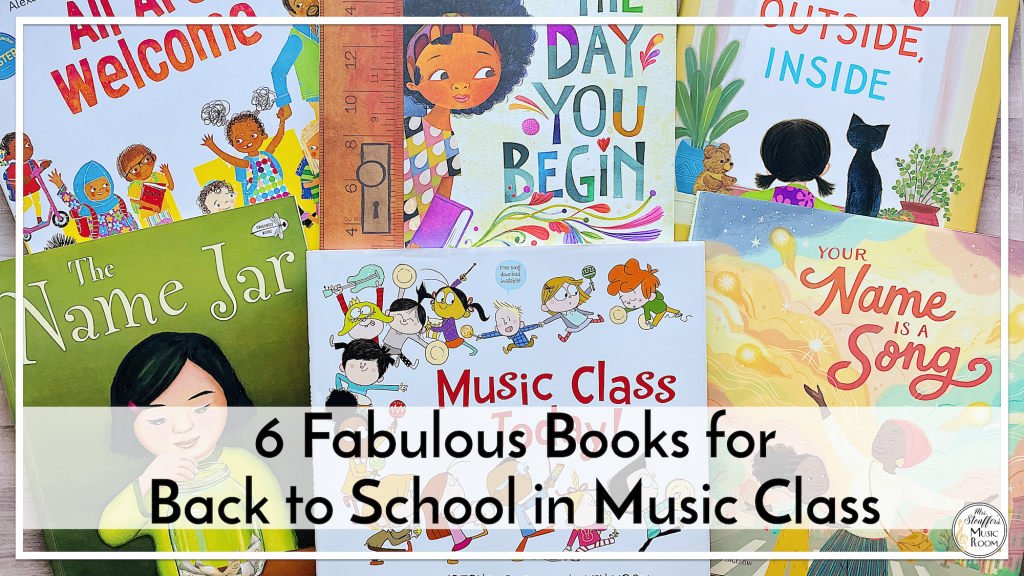The first few weeks of school always seem a little out of sorts. Getting back into the routine can be hard for some students. And teachers. The first few weeks are always more than getting right to learning so here is what to include in Back to School lessons.

1. Name Games
Unless you are in a super small town, or a school with very low turn over, chances are you’ll have some new names to learn in every grade. One or two isn’t a big deal but when it gets to be 5-10 in every class, it definitely involves spending some time on names. Definitely enforce correct pronunciation, names students want to be called, and remind students that it’s ok to correct you if you make a mistake. Check out this post with some of the Best Name Games for Music Class.

2. Get to Know You Activities
These are great when you do have those new students. Get a handle on what experiences they have, what they like, and a little about them, their home life, and other info like that. There are a few ways to do that. Play a game where students have to say something they like as a filler word like Jump In, Jump Out. Instead of playing with the students, sit and take notes. Another thing I liked to do with older classes involves a beach ball. Number each panel and wherever their right thumb lands is the question they have to answer. Let them make up the questions or make some easy ones like something you did this summer, favorite band, or other easy questions.
3. Welcome Activities
Make sure you take time to welcome the kids. Hi, I missed you all, and it’s good to see you. I can’t wait to make music together. Simple, easy, and sets the tone for your class. Books are great to include here, especially for new faces or students who need that reminder of what you are all about. It can be a great way to make sure all students feel included right out of the gate, to remind students that name pronunciation is important, and that music is supposed to be fun. Play a game, read a book, or ask what their favorite part of break was (doing this as yes/no questions can be helpful for students who may not know what to say). Here’s some starter questions. Try not to focus on specifics too much so that students who’s families can’t afford extras don’t feel left out. “Who…
- …read a book?”
- …went on a trip?”
- …had a staycation?”
- ….saw someone they haven’t seen in a while?”
- …spent time with friends?”
- …spent time with family?”
- …played outside?”
- …played in the water?”
- …played inside?”
- …played a video game?”
- …listened to music?”
- …and so on.
Check out this post with six fabulous books for back to school.

4. Procedures
Teaching students procedures, for everything, saves you time. It let’s them know what to do in every situation, how to handle certain things, and to know what’s expected of them. It’s an important part of classroom management that the longer you do, the easier it becomes for students to know what to do. After a few years of teaching procedures, you won’t even have to remind older students. Check out this post with a huge list of procedures to teach, and get a free checklist.

5.. Rules and Expectations
Set them on day 1. Let the students know what you expect out of them. All rules don’t have the same weight (think don’t tackle a classmate playing Cut The Cake vs a kid that got a little too excited and hit the drum a little harder than they should have by accident while singing). I let students know my non-negotiable rules – the ones that absolutely have more weight: Be Kind, and Be Safe. You can read more about what it looks like for me me in this post.

6. Assessment
This seems like a “what?”, but it’s actually something you may need to do. If you have to do student learning objectives, or even if you don’t, you need to know where the students are at in their skills. When you have new students, you don’t know what they learned in their old school, how their teacher taught, or their background. Doing some easy assessments like Four Corners (check out this post to see how to play), a quick written activity, or a mini test are great ways to do this depending on your needs. If you don’t need to capture student’s pre-assessment for records then four corners is a fun way to play so students don’t know they are being assessed. You can even combine cards in the corners so there is a mix of rhythm and solfège or other concepts so you can get a pulse on where your students are at.
I hope that this has been helpful giving you some ideas on what to include for back to school lessons!






